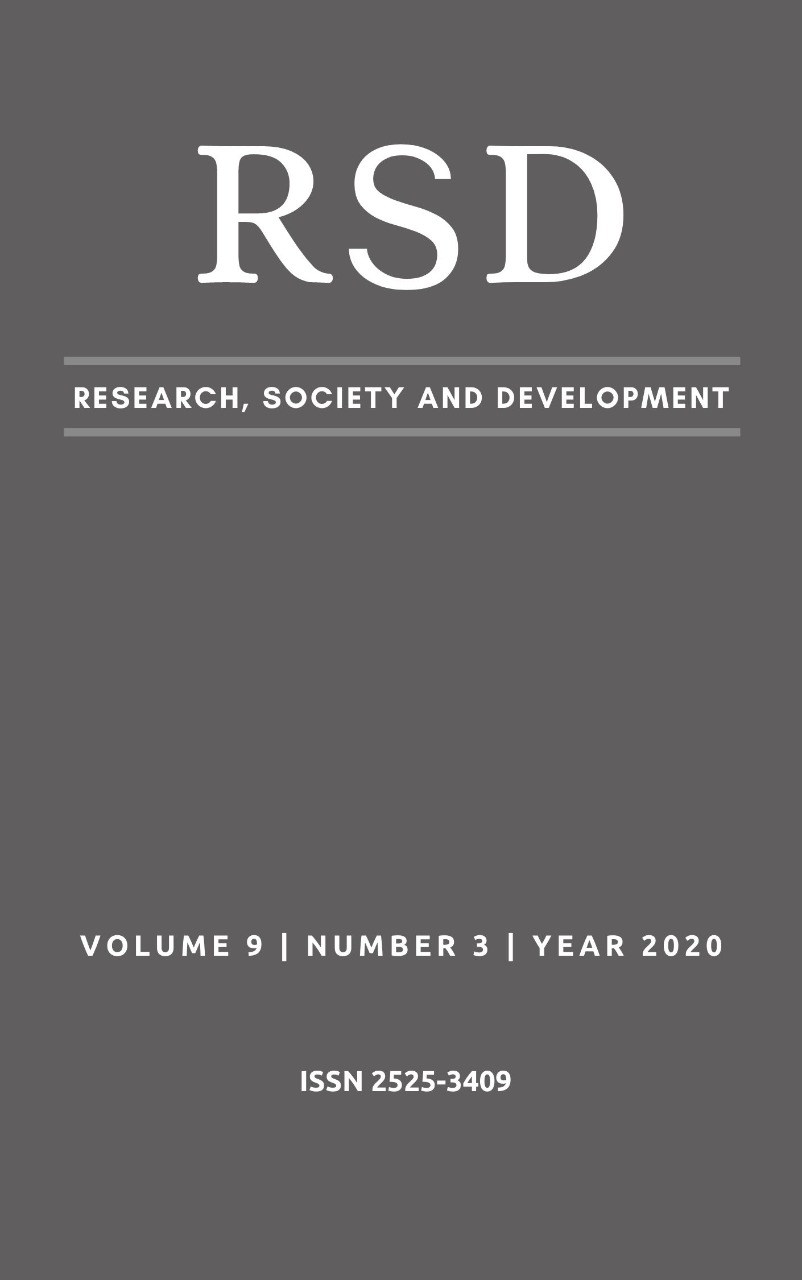A ordem civilizadora da barbárie: o sistema prisional feminino no brasil
DOI:
https://doi.org/10.33448/rsd-v9i3.2769Palavras-chave:
Sistema Prisional Feminino. Direitos Humanos. Estado Penal. Mulheres. Psicologia Social.Resumo
Este artigo consiste na análise, por meio de pesquisa bibliográfica, acerca da dualidade entre civilização e barbárie, através da permeação do Estado penal na contemporaneidade e suas relações com a Declaração Universal dos Direitos humanos, utilizando da ótica do Sistema Prisional Feminino no Brasil. Para essa análise, foram abordados temas referentes ao sexismo, racismo, capitalismo e a restrita ação dos Direitos humanos, preeminentes no status quo social e hierarquizado ao qual o Estado penal mantém. Frente a isso, o surgimento de uma cultura punitiva preconizada pelas instâncias políticas reforça a construção de mais “instituições de sequestro” através de uma manifestação do Estado em manter o poder hierárquico diante da individualidade das detentas, privando-as de seus direitos e fixando essa sujeição à estrutura disciplinar em que predomina a falta de recursos básicos para sua saúde física e psicológica. Assim, o intuito principal do artigo é abrir a discussão sobre a quem são voltados os Direitos humanos e questionar as instituições prisionais através da ideia de abolicionismo penal, utilizando dos estudos em Psicologia Social e autores como Michel Foucault, Katie Arguello, Drauzio Varella e Angela Davis.
Referências
Andrade, V. (2012). Pelas mãos da criminologia: o controle penal para além da (des) ilusão. (Coleção Pensamento Criminológico, v. 19). Rio de Janeiro: Revan.
Arguello, K. (2013). Do Estado social ao Estado penal: invertendo o discurso da ordem. Recuperado de: http://icpc.org.br/wp-content/uploads/2013/01/Artigo-Katie.pdf [Acesso em 23 Set. 2019]
Baratta, A. (1993). Direitos Humanos: entre a violência e a violência penal. Fascículos de Ciências Penais, (2), 49.
Bardin, L. (2010). Análise de conteúdo. (4a ed.). Lisboa: Edições70.
Bauman, Z. (2000). Em busca da política. Rio de Janeiro (RJ): Zahar.
Batista, V. (2009). O medo na cidade do Rio de Janeiro: dois tempos de uma história. (2a ed.). Rio de Janeiro (RJ): Revan.
Batista, V. (2011). Introdução crítica à criminologia brasileira. Rio de Janeiro: Revan.
Brasil. Ministério da Justiça e Segurança Pública. Departamento Penitenciário Nacional. INFOPEN Mulheres. (2018). Recuperado de: http://depen.gov.br/DEPEN/depen/sisdepen/infopenmulheres/infopenmulheres_arte_07-03- 18.pdf [Acesso em 7 Out. 2019]
Brasil. Ministério da Saúde. Plano Nacional de Saúde no Sistema Penitenciário. (2003). Recuperado de: http://bvsms.saude.gov.br/bvs/publicacoes/cartilha_pnssp.pdf [Acesso em 2 Dez. 2019]
Brasil. Conselho Nacional de Justiça. Banco Nacional de Monitoramento de Prisões. (2018).
Canazaro, D. & Argimon, I. (2019). Características, sintomas depressivos e fatores associados em mulheres encarceradas no Estado do Rio Grande do Sul, Brasil. Recuperado de: http://www.scielo.br/pdf/csp/v26n7/11.pdf [Acesso em 29 Nov. 2019]
Castro, L. (1983). Criminologia da reação social. Rio de Janeiro (RJ): Forense.
Chesnais, F. (1996). A mundialização do capital. São Paulo (SP): Xamã.
Constituição da República Federativa do Brasil de 1988. (1998). Brasília.
Foucault, M. (2014). Microfísica do poder. (28a ed.). São Paulo (SP): Paz e Terra.
Foucault, M. (2014). Vigiar e punir: nascimento da prisão. (42a ed.). Petrópolis (RJ): Vozes.
Freitas, C. (2014). O cárcere feminino: do surgimento às recentes modificações introduzidas pela lei de execução penal. Pensar. Recuperado de: http://revistapensar.com.br/direito/pasta_upload/artigos/a187.pdf [Acesso em 2 Dez. 2019].
Garland, D. (2005). Capital punishment and American culture. Punishment & Society, 7(4), p.347-376.
Howard, C. (2006). Direitos humanos e mulheres encarceradas (pp. 21-22). São Paulo: Instituto Terra, Trabalho e Cidadania e Pastoral Carcerária.
Karam, M. (2015). Os paradoxais desejos punitivos de ativistas e movimentos feministas. Justificando. Recuperado de: http://www.justificando.com/2015/03/13/os-paradoxais-desejos-punitivos-de-ativistas-e-movimentos-feministas/ [Acesso em 5 Dez. 2019].
Lei de execução penal (1984). Brasília. Recuperado de: http://www.planalto.gov.br/ccivil_03/leis/l7210.htm [Acesso em 2 Dez. 2019].
Lienert, G. (1989). Construção e análise de testes. München: Psychologie Verlags Union.
Machado, J. R. (2017). O “ser mulher” no sistema prisional. (Trabalho final de graduação). Universidade Federal de Santa Catarina, Florianópolis, Rio Grande do Sul, Brasil.
Marconi, M., & Lakatos, E. (2002). Técnicas de pesquisa (5a ed.). São Paulo (SP): Atlas.
Minzon, C., Danner, G. & Barreto, D. (2010). Sistema prisional: conhecendo as vivências da mulher inserida neste contexto. Universidade Paranaense (UNIPAR): Akrópolis, 18(1), 71-81.
Modesti, M. (2013). Mulheres aprisionadas: as drogas e as dores da privação da liberdade. Chapecó: Argos.
Queiroz, N. (2015). Presos que menstruam. (9a ed.). Rio de Janeiro: Record.
Rusche, G. & Kirchheimer, O. (1999). Punição e estrutura social. Rio de Janeiro: Freitas Bastos.
Santos, M., Alves, V., Pereira, A., Rodrigues, D., Marchiori, G., & Guerra, J. (2019). A saúde física de mulheres privadas de liberdade em uma penitenciária do estado do Rio de Janeiro. Recuperado de: http://www.scielo.br/scielo. Php?Pid=S1414-81452017000200205&script=sci_abstract&tlng=pt [Acesso em 2 Dez. 2019]
Soldatelli, B & Wedding, J. (2018). Direitos humanos no encarceramento feminino: um enfoque para o acesso a saúde como garantia da dignidade humana. Recuperado de: https://7seminario.furg.br/images/arquivo/240.pdf [Acesso em 4 Dez. 2019].
Trindade, R. (2018). Foucault - Por que a prisão?. Razão Inadequada. Recuperado de: https://razaoinadequada.com/2018/11/11/foucault-por-que-a-prisao/ [Acesso em 7 Dez. 2019].
Varella, Drauzio. (2017). Prisioneiras. São Paulo (SP): Companhia das Letras.
Young, J. (2002). A sociedade excludente. Rio de Janeiro: Revan.
Downloads
Publicado
Edição
Seção
Licença
Autores que publicam nesta revista concordam com os seguintes termos:
1) Autores mantém os direitos autorais e concedem à revista o direito de primeira publicação, com o trabalho simultaneamente licenciado sob a Licença Creative Commons Attribution que permite o compartilhamento do trabalho com reconhecimento da autoria e publicação inicial nesta revista.
2) Autores têm autorização para assumir contratos adicionais separadamente, para distribuição não-exclusiva da versão do trabalho publicada nesta revista (ex.: publicar em repositório institucional ou como capítulo de livro), com reconhecimento de autoria e publicação inicial nesta revista.
3) Autores têm permissão e são estimulados a publicar e distribuir seu trabalho online (ex.: em repositórios institucionais ou na sua página pessoal) a qualquer ponto antes ou durante o processo editorial, já que isso pode gerar alterações produtivas, bem como aumentar o impacto e a citação do trabalho publicado.


